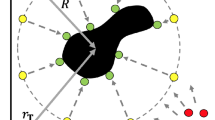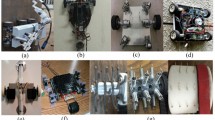Abstract
Minimizing the energy and flow consumption is significant to realize the locomotion of a hydraulically actuated hexapod robot for mobile field applications. This paper proposes a low energy cost foot trajectory planning method to realize a constant velocity of the body and optimize the power and flow consumption of a hexapod robot. A dephased gait generating method is also proposed to decrease the flow demand. A simulation platform for hexapod robots was developed using C++ and based on the vortex physics engine. Power and flow consumption models were derived to verify the proposed methods. The simulation platform was used to verify the effectiveness of the proposed methods at optimizing the power and flow consumption.
Similar content being viewed by others
References
E. Garcia, M. A. Jimenez, P. G. De Santos and M. Armada, The evolution of robotics research, IEEE Robotics & Automation Magazine, 14 (1) (2007) 90–103.
M. L. Hunt, Robotic walking in the real world, Science, 339 (6126) (2013) 1389–1390.
P. G. De Santos, E. Garcia, R. Ponticelli and M. Armada, Minimizing energy consumption in hexapod robots, Advanced Robotics, 23 (6) (2009) 681–704.
J. Estremera, J. A. Cobano and P. G. De Santos, Continuous free-crab gaits for hexapod robots on a natural terrain with forbidden zones: An application to humanitarian demining, Robotics and Autonomous Systems, 58 (5) (2010) 700–711.
X. L. Ding and F. Yang, Study on hexapod robot manipulation using legs, Robotica, 32 (6) (2014) 1–14.
Z. Y. Wang, X. L. Ding and A. Rovetta, Analysis of typical locomotion of a symmetric hexapod robot, Robotica, 28 (6) (2010) 893–907.
M. Kalakrishnan, J. Buchli, P. Pastor, M. Mistry and S. Schaal, Learning, planning, and control for quadruped locomotion over challenging terrain, The International J. of Robotics Research, 30 (2) (2011) 236–258.
U. Saranli, M. Buehler and D. E. Koditschek, RHex: A simple and highly mobile hexapod robot, The International J. of Robotics Research, 20 (7) (2001) 616–631.
S. M. Song and K. J. Waldron, Machines that walk: The adaptive suspension vehicle, MIT Press, Cambridge, USA (1989).
M. Raibert, B. Kevin, G. Nelson and R. Playter, Bigdog, the rough-terrain quadruped robot, Proc. of the 17th IFAC World Congress, Seoul, Korea (2008) 10822–10825.
R. Hodoshima, T. Doi, Y. Fukuda, S. Hirose, T. Okamoto and J. Mori, Development of a quadruped walking robot TITAN XI for steep slope operation, J. of Robotics and Mechatronics, 19 (1) (2007) 13–19.
C. Semini, N. G. Tsagarakis, E. Guglielmino, M. Focchi, F. Cannella and D. G. Caldwell, Design of HyQ–a hydraulically and electrically actuated quadruped robot, Proc. of the Institution of Mechanical Engineers, Part I: J. of Systems and Control Engineering, 225 (6) (2011) 831–849.
C. Semini, N. G. Tsagarakis, E. Guglielmino and D. G. Caldwell, Design and experimental evaluation of the hydraulically actuated prototype leg of the HyQ robot, Proc. of the International Conference on Intelligent Robots and Systems, Taipei, Taiwan (2010) 3640–3645.
X. W. Rong, Y. B. Li, J. H. Ruan and B. Li, Design and simulation for a hydraulic actuated quadruped robot, JMST, 26 (4) (2012) 1171–1177.
A. Irawan and K. Nonami, Compliant walking control for hydraulic driven hexapod robot on rough terrain, J. of Robotics and Mechatronics, 23 (1) (2011) 149–162.
A. Irawan and K. Nonami, Optimal impedance control based on body inertia for a hydraulically driven hexapod robot walking on uneven and extremely soft terrain, J. of Field Robotics, 28 (5) (2011) 690–713.
M. Hildebrand, Symmetrical gaits of horses, Science, 150 (3697) (1965) 701–708.
K. Xu and X. L. Ding, Typical gait analysis of a six-legged robot in the context of metamorphic mechanism theory, Chinese J. of Mechanical Engineering, 26 (4) (2013) 771–783.
D. Chang, J. Kim, D. Choi, K. J. Cho, T. Seo and J. Kim, Design of a slider-crank leg mechanism for mobile hopping robotic platforms, JMST, 27 (1) (2013) 207–214.
M. S. Erden, Optimal protraction of a biologically inspired robot leg, J. of Intelligent & Robotic Systems, 64 (3-3) (2011) 301–322.
M. F. Silva and J. A. Machado, Kinematic and dynamic performance analysis of artificial legged systems, Robotica, 26 (01) (2008) 19–39.
S. S. Roy and D. K. Pratihar, Effects of turning gait parameters on energy consumption and stability of a six-legged walking robot, Robotics and Autonomous Systems, 60 (1) (2012) 72–82.
S. H. Cho and P. Noskievic, Position tracking control with load-sensing for energy-saving valve-controlled cylinder system, JMST, 26 (2) (2012) 617–625.
L. Ding, Y. Q. Liu, H. B. Gao, M. Jin, Z. Liu, N. Li and Z. Q. Deng, Center of mass and its domain for heavy hexapod robots, Proc. of the International Conference on Mechatronics and Control, Jinzhou, China (2014) 453–458.
Y. Sakakibara, K. Kan, Y. Hosoda, M. Hattori and M. Fujie, Foot trajectory for a quadruped walking machine, Proc. of the International Conference on Intelligent Robots and Systems, Ibaraki, Japan (1990) 315–322.
J. M. Porta and E. Celaya, Reactive free-gait generation to follow arbitrary trajectories with a hexapod robot, Robotics and Autonomous Systems, 47 (4) (2004) 187–201.
L. Z. Xu, W. H. Liu, Z. Y. Wang and W. F. Xu, Gait planning method of a hexapod robot based on the central pattern generators: simulation and experiment, Proc. of the IEEE International Conference on Robotics and Biomimetics, Shenzhen, China (2013) 698–703.
L. Ding, H. B. Gao, Z. Q. Deng, J. H. Song, Y. Q. Liu, G. J. Liu and K. Iagnemma, Foot-terrain interaction mechanics for legged robots: Modeling and experimental validation, The International J. of Robotics Research, 32 (13) (2013) 1585–1606.
Y. Q. Liu, Z. Q. Deng, Z. Liu, L. Ding, H. B. Gao and Y. C. Li, Low-impact motion planning method of hydraulically actuated hexapod robot, J. of Mechanical Engineering, 51 (3) (2015) 10–17 (in Chinese).
Author information
Authors and Affiliations
Corresponding author
Additional information
Recommended by Associate Editor Kyoungchul Kong
Zongquan Deng is a professor and a vice president at the Harbin Institute of Technology, China. He received his M.S. at the Harbin Institute of Technology, China, in 1984. His research interests include special robot systems and aerospace mechanisms and control.
Yiqun Liu is a Ph.D. candidate at the State Key Laboratory of Robotics and System, Harbin Institute of Technology, China. He received his M.S. at the Harbin Institute of Technology at Weihai, China, in 2011. His research interests include mobile robotics and special vehicles.
Liang Ding is a professor at the State Key Laboratory of Robotics and System, Harbin Institute of Technology, China. He received his Ph.D. at the Harbin Institute of Technology, China, in 2009. His research interests include field and aerospace robotics and control.
Haibo Gao is a professor at the State Key Laboratory of Robotics and System, Harbin Institute of Technology, China. He received his Ph.D. at the Harbin Institute of Technology, China, in 2004. His research interests include specialized and aerospace robotics and mechanisms.
Haitao Yu received his B.S., M.S. and Ph.D. in Mechanical Engineering from Harbin Institute of Technology in 2007, 2009 and 2014, respectively. He is currently a visiting scholar at system and control lab in Ryerson University, Canada. His research interests include legged locomotion, bio-inspired robotics and nonlinear systems.
Zhen Liu was born in 1983, and is currently a lecturer at the State Key Laboratory of Robotics and System, Harbin Institute of Technology, China. He received his Ph.D. degree at the Harbin Institute of Technology, China, in 2013. His research interests include aerospace robotics.
Rights and permissions
About this article
Cite this article
Deng, Z., Liu, Y., Ding, L. et al. Motion planning and simulation verification of a hydraulic hexapod robot based on reducing energy/flow consumption. J Mech Sci Technol 29, 4427–4436 (2015). https://doi.org/10.1007/s12206-015-0941-0
Received:
Revised:
Accepted:
Published:
Issue Date:
DOI: https://doi.org/10.1007/s12206-015-0941-0




